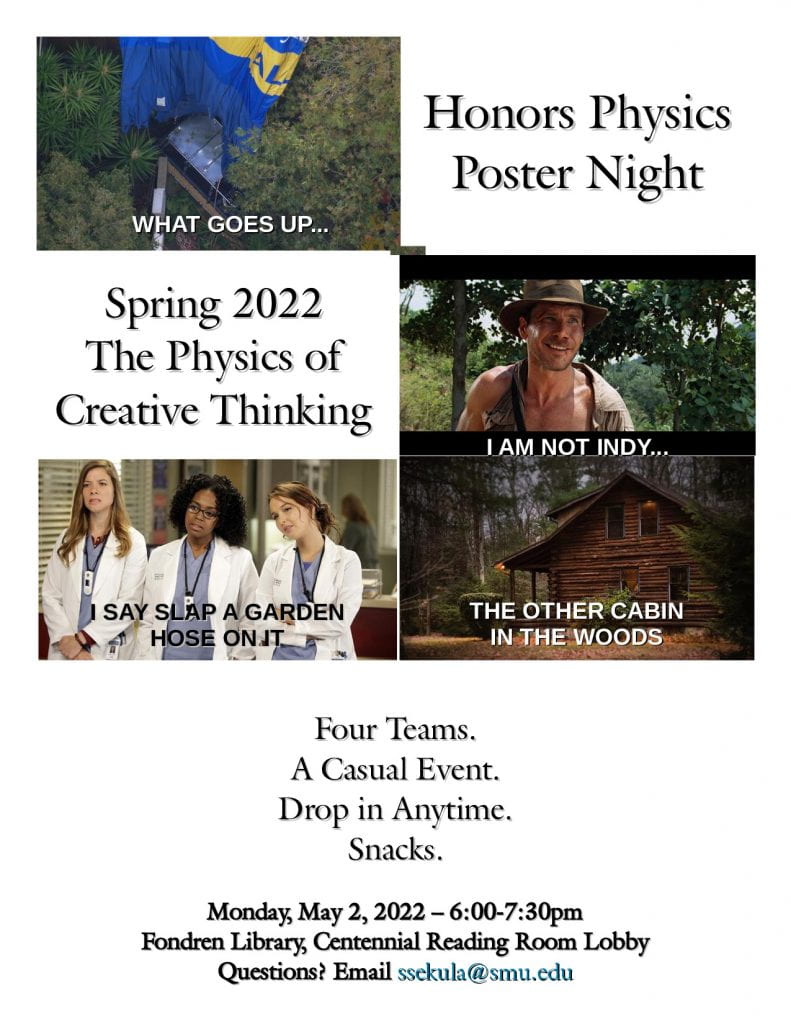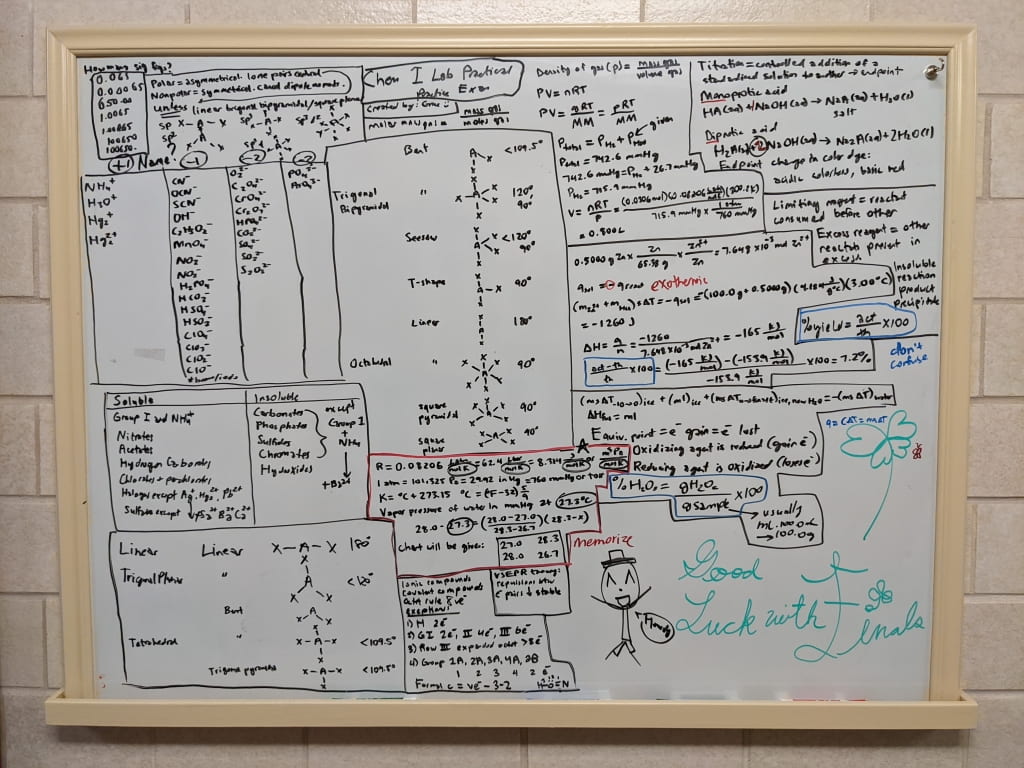
In this edition of the Friday Newsletter, we put all of our attention on the big events on Monday, May 2 as we close out the semester and get ready for finals and graduation!
Contents
CHAIR’S WEEKLY MESSAGE
Dear Radioactive Ladies and Gentlemen
So began Wolfgang Pauli’s famous letter to the participants of a physics meeting in Tubingen, Germany. The letter’s contents contained his proposed solution to the problem of beta decay. A copy of the letter, typed up by Lise Meitner (quite a famous nuclear physicist as well!) and provided to Pauli in 1956, is shown below.

Beta decay was the observation of the emission of fast-moving electrons from certain unstable atomic nuclei. It was observed that the electron could have any of a range of energies, rather than coming out with one sharp energy … as would be predicted if it, and the recoiling daughter nucleus, were the only products of the radioactive process. There were at least a few choices to explain this observation, one of which was to abandon conservation of energy on the nuclear scale of matter. Pauli proposed the alternative idea of an additional particle, produced in the reaction, which he dubbed the “Neutron” in his letter. It would be electrically neutral, almost impossible to detect (as it would already seen have been observed), and would, in his view, be therefore “… a desperate remedy to save the ‘exchange theorem’ of statistics and the law of conservation of energy.”
In 1956, after nuclear reactors became a well-developed technology, an experiment was carried out at the Savannah River Nuclear Power Plant by a team looking for the inverse beta capture process … the process of capturing the neutrino and emitting an electron and changing a nucleus in the process. The 10 trillion neutrinos per second, per square centimeter produced by the nuclear reactor allowed, with careful shielding and instrumentation, for a handful of these neutrinos to be stopped and detected by this process. This was sufficient to discover the neutrino, Pauli’s renamed “Neutron” (when James Chadwick discovered what we now call the neutron, and it was so dubbed with that name, Enrico Fermi suggested an alternative name – “neutrino” – for Pauli’s “desperate remedy”).
We can see beta rays – fast electrons – in the feature image (animated GIF) at the top of this newsletter. These are produced from thorium present in a “camping mantle” – the wick of a camping lantern that, prior to about 1990, contained thorium on purpose as they improved the quality of the light. After the early 1990s, Coleman eliminated thorium from camping mantles. This was naturally occurring Thorium, Th-232, which can decay via beta radiation to Actinium, Lead, Radium, or Tellurium. The betas appear as long, thin, straight tracks in the cloud chamber where this video was taken. Unseen are the neutrinos, which almost never interact with such a thin, wispy gas.
The discovery of the neutrino opened a new era of particle physics. What was once a desperate remedy became a target of intense study. By the time I went to graduate school in 1998, the neutrino had just unveiled its greatest feature: evidence of its hitherto unknown mass (which was assumed to be zero … a bad assumption, as it turned out). Neutrino astronomy became a field in the late 1990s and early 2000s, neutrinos have already brought us information from the cores of stars (living and dying), and they are key ingredients in particle physics programs across the globe. We are fortunate to welcome a luminary, Prof. Bonnie Fleming, to show us the puzzles still associated with this most phantom of known particles.
In this edition, we focus on all the great stuff happening on Monday, May 2! We have the last colloquium of the semester, the lecture by Prof. Fleming; we have Honors Physics Poster Night; and we have a reception for the speaker and end-of-term celebration for the Physics Department and its many alumni and friends!
Sincerely,

Stephen Jacob Sekula Chair, Department of Physics |
DEPARTMENT VIEWS
The Spring Colloquium on May 2, 2022: “The Phantom Particle: New Puzzles from Neutrinos”
 We are pleased to welcome our distinguished speaker for the final event of 2021-2022 Physics Department Speaker Series! Professor Bonnie Fleming (Yale University), a global leader in the neutrino community and in the scientific community as regards the basic research enterprise, will speak on May 2 on “The Phantom Particle: New Puzzles from Neutrinos.”
We are pleased to welcome our distinguished speaker for the final event of 2021-2022 Physics Department Speaker Series! Professor Bonnie Fleming (Yale University), a global leader in the neutrino community and in the scientific community as regards the basic research enterprise, will speak on May 2 on “The Phantom Particle: New Puzzles from Neutrinos.”
All are welcome for the lecture from 4-5pm in FOSC 123 on that date.
A private reception for the speaker and the Physics Department and its community will follow the event. If you have not been invited, but wish to attend, please contact the department chair for information.
Prof. Fleming is a remarkable scientist and leader. She is the founding spokesperson of the MicroBooNE collaboration at Fermilab (the position of “Spokesperson” on a science collaboration is the highest available leadership position). She presently serves as MicroBooNE’s scientific co-spokesperson. Her group has been involved in the MicroBooNE experiment at every possible level, from hardware to software to data analysis, measurement, and publication.
She is also the founding spokesperson of the ArgoNeuT experiment and an active collaborator on the ArgoNeuT, LArIAT, SBND, and future DUNE experiments at Fermilab. The development of Liquid Argon Time Projection Chambers (LArTPC) is core to her group’s efforts and an essential technology for these programs.
Fleming received the American Physical Society (APS) Division of Particles and Fields (DPF) mentoring award in 2018 and presently serves at Yale as the Director of Graduate Students (DGS) in Physics. She also initiated the Girls Science Investigations through her NSF CAREER grant in 2006. This is a Saturday program for middle school-aged girls in New Haven. Participants engage in hands-on science experiments at Yale, guided by a team of volunteer mentors. It continues today with private donations and funding through Yale University. Many people from the Yale Physics Community participate as mentors in this program.

Refreshments are served in the Hyer Ed Cafe in FOSC 16 around 3:45pm, and the event begins in FOSC 123 at 4pm (it’s a 1 minute walk between those two rooms). We welcome all participants!
Past Speaker Series events are available from our YouTube playlist. Catch up any time!
Honors Physics Poster Night: May 2, 6:00pm-7:30pm (ALL ARE WELCOME!)
You are cordially invited to drop in for Honors Physics Poster Night on Monday, May 2. The event will be held in the lobby of the Centennial Reading Room in Fondren Library (on the second floor, above ground level). The event begins at 6:00 and ends at 7:30pm. All are welcome!
Four teams in Honors Physics, including a student from Highland Park High School who has been shadowing the instructor (Prof. Stephen Sekula) and participating in the course, have been developing their posters around the idea of “The Physics of Creative Thinking.” Early in the semester, teams built camaraderie by competing in a trivia competition for resources to support their projects. Each team, using their “winnings” from the competition, selected three items they could use to solve or support their problems.
The audience is invited to engage with the students, listen to their short presentations, ask lots of questions, and then evaluate the teams if they like. We welcome all from the SMU community to not only immerse themselves in the outcomes of this course, but to meet these outstanding students!

FACULTY NEWS
If you have something to share please feel free to send it along. Stories of your activities in research, the classroom, and beyond are very welcome!
End of Term News: Tuesday is a Friday, Final Exams, Final Grades, and Graduation!
Faculty are reminded that:
- Tuesday, May 3 follows a Friday schedule, to make up for Good Friday. MWF classes meet for their last period on Tuesday. Tuesday and Thursday classes are done as of yesterday (April 28).
- Final Exams begin Thursday, May 5.
- Final grades are due not more than 72 hours after your final exam. Get those grades in so the university can update transcripts and confirm graduating seniors!
- The department will have a celebration of its Physics majors and minors on Friday, May 13. Watch for upcoming announcements and save the date!
STAFF NEWS
The department staff continue to work on behalf of Research Operations (Michele Hill) and Academic Operations (Benisha Young). They can be contacted for assistance, or to make appointments for input and help, through the Department Main Office (FOSC 102).
STUDENT NEWS
If you have something to share please feel free to send it along. Stories of students in research, the classroom, internships or fellowships, awards, etc. are very welcome!
ALUMNI NEWS
If you are an alum of the doctoral, masters, majors or minor programs in Physics at SMU, or have worked in our program as a post-doctoral researcher, and wish to share news with the community, please send your story to the Physics Department and we’ll work with you to get it included in a future edition.
THE BACK PAGE
Whiteboard Art
Put a whiteboard out in the open and beautiful things can happen. Here is some whiteboard art – some actual drawing, some just the result of intense studying – that we found on whiteboards in Fondren Science Building.





